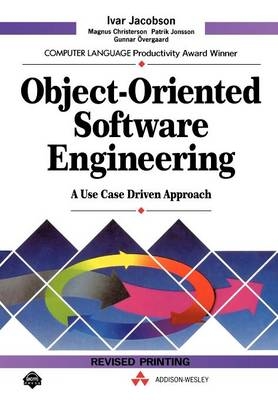
Object Oriented Software Engineering
Addison Wesley (Verlag)
978-0-201-54435-0 (ISBN)
- Titel ist leider vergriffen;
keine Neuauflage - Artikel merken
How can software developers, programmers and managers meet the challenges of the 90s and begin to resolve the software crisis? This book is based on Objectory which is the first commercially available comprehensive object-oriented process for developing large-scale industrial systems. Ivar Jacobson developed Objectory as a result of 20 years of experience building real software-based products. The approach takes a global view of system development and focuses on minimizing the system's life cycle cost. Objectory is an extensible industrial process that provides a method for building large industrial systems. This revised printing has been completely updated to make it as accessible and complete as possible. New material includes the revised Testing chapter, in which new product developments are discussed.
Dr. Ivar Jacobson, Vice President of Business Engineering, is the inventor of the OOSE method, and he is also the founder of Objectory AB in Sweden, which recently merged with Rational Software Corporation. Dr. Jacobson is the principal author of two influential and best-selling books Object-Oriented Software Engineering--A Use Case Driven Approach (Computer Language Productivity award winner in 1992) and The Object Advantage--Business Process Reengineering with Object Technology. He has also authored several widely referenced papers on object technology. One of the most famous papers is his first OOPSLA '87 paper entitled "Object-Oriented Development in an Industrial Environment," which presented the first truly object-oriented method ever published. Ivar Jacobson's use-case driven approachhas had a very strong impact on the entireOOAD industry, and he himself has become one of its "icons." Consequently, he isa frequently invited keynote speaker and panelist, debating OOAD topics withcolleagues and methodologists such as Grady Booch, Jim Rumbaugh, StevenMellor, and Rebecca Wirfs-Brock at major OO conferences around the world. He is well known for his pioneering work and more than 20 years of experience inusing object methods for the design of large real-time systems. His earlyobject-based design technique has evolved into the international standardITU(formerly CCITT)/SDL. Dr. Jacobson also regularly serves on the OOPSLA, ECOOP, and TOOLSprogram committees, and he is a member of the advisory board of the Journal ofObject-Oriented Programming. In 1994, Ivar Jacobson received the first Swedish Computer Association (SCA)award (the Kjell Hultman prize) for "extraordinary achievement in promotingefficiency and productivity in the development and use of informationtechnology." Patrik Jonsson works at Rational Software Corporation in Sweden as a Senior Consultant where he has been developing the architecture and method of the Objectory process with a current focus on reuse and user interface development. 0201544350AB04062001
Part 1. Introduction
1. System development as an industrial process
Introduction
A useful analogy
System development characteristics
Summary
2. The system life cycle
Introduction
System development as a process of change
System development and reuse
System development and methodology
Objectory
Summary
3. What is object-orientation? Introduction
Object
Class andinstance
Polymorphism
Inheritance
Summary
4. Object-oriented system development Introduction
Function/data methods
Object-oriented analysis
Object-oriented construction
Object-oriented testing
Summary
5. Object-oriented programming Introduction
Objects
Classes and instances
Inheritance
Polymorphism
An example
Summary
Part II. Concepts
6. Architecture Introduction
System development is model building
Model architecture
Requirements model
Analysis model
The design model
The implementation model
Test model
Summary
7. Analysis Introduction
The requirements model
The analysis model
Summary
8. Construction Introduction
The design model
Block design
Working with construction
Summary
9. Real-time specialization Introduction
Classification of real-time systems
Fundamental issues
Analysis
Construction
Testing and verification
Summary
10. Database Specialization Introduction
Relational DBMS
Object DBMS
Discussion
Summary
11. Components Introduction
What is a component?
Use of components
Component management
Summary
12. Testing Introduction
On testing
Unit testing
Integration testing
System testing
The testing process
Summary
Part III. Applications
13. Case study: warehouse management system Introduction to the examples
ACME Warehouse Management Inc.
The requirements model
The analysis model
Construction
14. Case study: telecom Introduction
Telecommunication switching systems
The requirements model
The analysis model
The design model
The implementation model
15. Managing object-oriented software engineering Introduction
Project selection and preparation
Project development organization
Project organization and management
Project staffing
Software quality assurance
Software metrics
Summary
16. Other object-oriented methods Introduction
A summary of object-oriented methods
Object-Oriented Analysis (OOAD/Coad-Yourdon)
Object-Oriented Design (OOD/Booch)
Hierarchical Object-Oriented Design (HOOD)
Object Modeling Technique (OMT)
Responsibility-Driven Design
Summary
Appendix A On the development of Objectory Introduction
Objectory as an activity
From idea to reality
References
Index
| Erscheint lt. Verlag | 11.7.1992 |
|---|---|
| Verlagsort | Harlow |
| Sprache | englisch |
| Maße | 177 x 242 mm |
| Gewicht | 910 g |
| Themenwelt | Informatik ► Software Entwicklung ► Objektorientierung |
| ISBN-10 | 0-201-54435-0 / 0201544350 |
| ISBN-13 | 978-0-201-54435-0 / 9780201544350 |
| Zustand | Neuware |
| Haben Sie eine Frage zum Produkt? |
aus dem Bereich


